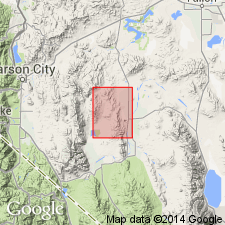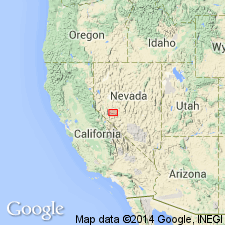
- Usage in publication:
-
- Singatse Tuff
- Modifications:
-
- Named
- Dominant lithology:
-
- Tuff
- AAPG geologic province:
-
- Great Basin province
Summary:
Named for Singatse Peak. Type area designated as exposures north of Singatse Peak, sec.13 T13N R24E, Singatse Range, Lyon Co, NV. Composed of brown, buff-brown to red-brown moderately welded ash-flow tuff forming crystal-rich cooling unit 240 to 460 m thick. Overlies Mickey Pass Tuff (new); underlies Bluestone Mine Tuff (new). Is Oligocene age.
Source: GNU records (USGS DDS-6; Menlo GNULEX).

- Usage in publication:
-
- Singatse Tuff*
- Modifications:
-
- Revised
- AAPG geologic province:
-
- Great Basin province
Summary:
Singatse Tuff of Proffett and Proffett (1976) included as middle formation of Benton Spring Group. Overlies Mickey Pass Tuff; underlies Petrified Spring Tuff (new) (both of Benton Spring Group). Is Oligocene age based on K-Ar age range of 28 to 24 Ma.
Source: GNU records (USGS DDS-6; Menlo GNULEX).
For more information, please contact Nancy Stamm, Geologic Names Committee Secretary.
Asterisk (*) indicates published by U.S. Geological Survey authors.
"No current usage" (†) implies that a name has been abandoned or has fallen into disuse. Former usage and, if known, replacement name given in parentheses ( ).
Slash (/) indicates name conflicts with nomenclatural guidelines (CSN, 1933; ACSN, 1961, 1970; NACSN, 1983, 2005, 2021). May be explained within brackets ([ ]).

